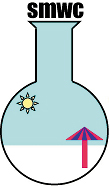|
|
Vol.
26 No. 1
January-February 2004
Bioinorganic Chemistry
by Stephen J. Lippard
The Santa María Workshop, organized by the University of Havana and the Cuban Chemical Society, took place 7–11 July 2003 in Havana, Cuba. This event takes place every year, during the first half of July. In the even years it is devoted to supramolecular chemistry and during the odd ones to bioinorganic chemistry. Prof. Roberto Cao, chairman of the workshop, and his laboratory of bioinorganic chemistry were mainly responsible for organizing the conference.
 The workshop takes its name from the marvelous beach Santa María del Mar, which is located 20 km east of Old Havana. Such a location guarantees a quiet and pleasant environment. The first day of activities occurs at the University of Havana, with the opening ceremony at its Aula Magna, a beautiful neoclassic building. The workshop takes its name from the marvelous beach Santa María del Mar, which is located 20 km east of Old Havana. Such a location guarantees a quiet and pleasant environment. The first day of activities occurs at the University of Havana, with the opening ceremony at its Aula Magna, a beautiful neoclassic building.
Five main topics were covered in the workshop: metal interactions with DNA and nucleotides, metalloporphyrins, copper compounds, metal nitrosyls, and the influence of genomics on bioinorganic chemistry.
Prof. Stephen Lippard (MIT, USA) presented the opening address, an excellent overview on cisplatin, a topic on which he is a world leader. Another view of metal-DNA interactions was given by Prof. Helmut Sigel (U. Basel, Switzerland) in his plenary lecture on “Adenosine 5’-triphosphate (ATP4-): Aspects of the Coordination Chemistry of a Multi-Talented Biological Substrate.”
Prof. Ivano Bertini, in his plenary lecture on “Perspectives in Inorganic Structural Biology,” discussed how genomics is influencing further development of bioinorganic chemistry. Dr. Kirill Degtyarenko (European Bioinformatics Institute, UK) complemented Bertini’s considerations on genomics in his invited lecture “The Ontology of Bioinorganic Proteins.” Dr. Roberta Pierattelli also discussed this topic (Univ. Florence, Italy) in her invited lecture entitled “Perspectives in NMR of Paramagnetic Copper Proteins.” Prof. Gianni Valensin (Univ. Siena, Italy) presented his invited lecture on “1H-NMR Studies of Copper(II) Complexes with Histidine-Containing Peptides.”
Studies of metalloporphyrins were presented by Prof. Jonathan L. Sessler (Univ. Texas at Austin, USA), who discussed results achieved at the University of Texas and Pharmacyclics, Inc., on lanthanide(III) texaphyrins (Tex), a family of expanded porphyrins containing five nitrogen donor atoms.
NiF430, a nickel tetrahydrocorphinoid cofactor of methyl-coenzyme M reductase (MCR), was analyzed in two invited lectures from different points of view. Prof. Joshua Telser (Rooselvelt Univ., USA) drew attention to variation in oxidation states of nickel according to EPR and ENDOR studies. He concluded that Ni(I) is the formal oxidation state of red1, ox1 and ox2 forms of MCR. On the other hand, Prof. Mark Zimmer (Connecticut College, USA) presented his results on the normal-coordinate structural decomposition, cluster analysis, and molecular calculations on NiF430. He explained how this cofactor has very little rotational and translational freedom within MCR.
Prof. Peter Ford (Univ. California at Santa Barbara, USA) presented a plenary lecture entitled “Probing Fundamental Mechanisms of Nitric Oxide Reactions with Metal Centers and Other Biologically Relevant Targets.” Attention was also drawn to nitrosyl complexes by Prof. Roberto Cao (Univ. Havana, Cuba) in his invited lecture “Copper(II) Complexes as Inorganic Radical Scavengers.” His coworker, Dr. Alicia Díaz gave more detailed information about this study, while Mayreli Ortiz described Ru(II) nitrosyl complexes. Finally, Dr. Alex Fragoso presented his results on Cu(II) cyclodextrin derivative complexes as SOD mimics. Prof. Wolfgang Kaim (Univ. Stuttgart, Germany) presented an interesting plenary lecture entitled “Cooperation of Metals with Electroactive Ligands of Biochemical Relevance: Beyond Metalloporphyrins.”
The last presentation of the workshop was the invited lecture of Prof. Lena Ruiz (UNAM, Mexico) entitled “New Anticancer Mixed Chelate Copper(II) Complexes (Casiopeinas): Activity, QSAR, and Adenine Interaction.” She presented information about the chemical and biological properties of copper(II) complexes of general formulae [Cu(N-N)(O-O)]NO3, registered in Mexico under the name of “Casiopeinas.”
On 9 July, a poster session was held featuring 15 posters from Cuban, Mexican, and Portuguese researchers. The closing dinner took place at “La Cabaña,” a 17th century Spanish fortress in which the traditional “Cañonazo” (gunshot) activity takes place every day at 9 PM.
The next workshop, III SMWC, will take place 12–15 July 2004. The lecturers who have already confirmed are Angela Danil de Namor (U. Surrey), Javier de Mendoza (U. Auton. Madrid), A.P. de Silva (Queens U.), Luis Echegoyen (Clemson U.), Achim Müller ( U. Bielefeld), Vincent Pecoraro (U. Michigan), Joszef Szejtli (Cyclolab), and Fritz Voegtle (U. Bonn). Stephen Lippard <[email protected]> is a professor in the Department of Chemistry at the Massachusetts Institute of Technology and is conference editor for the 2nd Santa Maria Workshop.
Page
last modified 8 January 2004.
Copyright © 2003-2004 International Union of Pure and
Applied Chemistry.
Questions regarding the website, please contact [email protected]
|